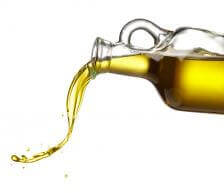When to Use Olive Oil
As healthy as it is, extra virgin olive oil isn’t always the smartest choice.

Secondly, olive oil is rich in polyphenols and antioxidants, which protect your cells against damage that can lead to cancer and heart disease. Olives also contain a newly discovered compound called oleocanthal, which has fairly potent anti-inflammatory effects. Eating anti-inflammatory foods like olive oil can help slow down the aging process, both inside and out, and even make it easier to lose weight and keep it off.
But when you go to buy olive oil, you’ve probably noticed that there are lots of different kinds. You’ve got your low-end, pale green stuff, which is often labeled 100% olive oil. And then you’ve got all kinds of high-end, bright green stuff, usually called extra virgin olive oil. Which kind should you buy? Both!
Why You Need Two Kinds of Olive Oil
To make olive oil, you basically squeeze olives and the oil drips out. Dissolved in the oil are aromatic compounds from the flesh of the olives. The same olives are then squeezed, or pressed, a number of times. But that first pressing, which produces what we call extra virgin olive oil, contains a much higher proportion of these plant extracts. That’s why it is so much darker and more flavorful than oils that come from later pressings. It’s also more expensive.
For those who are into fancy food, olive oil is the new wine. You can go to olive oil tastings where the talk is all about peppery notes, and spicy undertones, and fruity finishes. You can spend your vacation touring olive plantations in Napa. You can spend a lot of money on some really special olive oils.
But it doesn’t make sense to cook with the good stuff. The compounds that make extra virgin olive oil so tasty and so expensive are quite volatile. When they’re exposed to heat for any length of time, they break down or evaporate.
Save your extra virgin olive oil for salad dressings, drizzling over cooked vegetables, pasta, baked potatoes, or even popcorn. Or, pour it into a dish and dip hunks of bread into it. That’s when you’ll really be able to appreciate the flavor that you’re paying so much extra for. You’ll also be getting the health benefits of all those valuable plant compounds.
But for sauces, sautéing, or roasting vegetables in the oven or on the grill, reach for the 100% olive oil instead. You’re still getting the heart healthy benefits of the monounsaturated fats and you’re not wasting money on compounds that are largely destroyed in the cooking process.
What Other Oils Do You Need in the Kitchen?
Olive oil is great for the majority of cooking tasks, but you may want to have a couple of other oils on hand, as well. Even the lighter, more refined olive oils have a noticeable olive flavor that sometimes doesn’t go with what you’re cooking. Canola oil is perfect for those times when you want a very neutral flavor. Although it doesn’t have all the extra antioxidants and polyphenols that you get with olive oil, canola oil is also mostly monounsaturated fat
When you’re cooking over very high heat, such as stir-frying, choose peanut oil or an oil that’s specifically labeled for high-heat cooking. These have a very high smoke point, which means you can heat them to higher temperatures before they start setting off your smoke alarm. Frying foods at high temperatures reduces the amount of oil that the food absorbs, so the end result is lighter and crisper.
And finally, I like to keep one or two roasted nut or seed oils around, but these are used more as seasonings than cooking oils so a small amount goes a long way. For example, you might use a teaspoon of toasted sesame oil in an Asian dish or some walnut or hazelnut oil in a salad dressing. As these oils spoil easily, buy them in small quantities and store them in the fridge.
Although you’ll have occasional uses for these other oils, olive oil should ideally be the primary source of fat in your diet. In other words, you should be going through about three times as much olive oil as all other types of oil combined. But save your extra virgin olive oil for those times when you’ll get the most benefit and enjoyment and use the more economical 100% olive oil for cooking. For tips on storing oils properly, check out this Quick Tip.
Administrative
This is Monica Reinagel, the Nutrition Diva, with your quick and dirty tips for eating well and feeling fabulous.
These tips are provided for your information and entertainment and are not intended as medical advice. Because everyone is different, please work with your health professional to determine what’s right for you.
I’m launching a weekly Nutrition Diva newsletter, with more quick and dirty tips for eating well and feeling fabulous. It’s a way for me to share recipes, tips, and other extra goodies that don’t fit into the podcast episodes. It’s also a chance for me to answer more of your nutrition questions, so keep those coming as well. Just send an email to nutrition@quickanddirtytips.comcreate new email or leave me a voice mail at 206-203-1438. You can also reach me, and follow my latest tips, on Facebook or Twitter.
Thanks for listening. Have a great day and eat something good for me!
RESOURCES:
Monica’s killer roasted cauliflower recipe
Image courtesy of Shutterstock

